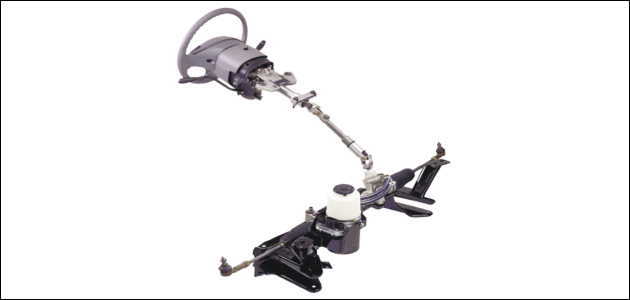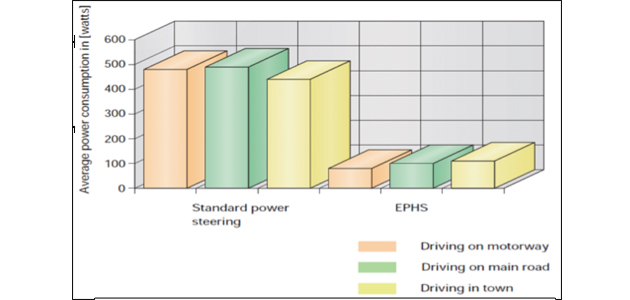
EPHS systems retain the steering properties of traditional belt driven hydraulic power assisted steering systems, whilst offering a range of benefits to the driver. These include improvements in comfort through reducing driver effort, easier operation when parking and low speed manoeuvring, whilst maintaining taught steering when driving at high speeds.
Producing power
The hydraulic energy is now produced by an electrically driven pump rather than a belt driven pump, as in traditional hydraulic power steering systems. Therefore, engine power can now be used to move the vehicle and power minimal ancillaries/auxiliaries via the drive belt rather than be wasted pumping hydraulic fluid unnecessarily. As the power produced by the engine can now be used more efficiently, there is a fuel saving in the region of 0.3 l/100km (or an extra 3.75 MPG) and a reduction of CO2 emissions in the region of 7g/km.
In an EPHS system, the hydraulics continue to assist the human steering input effort. However, the hydraulic pump – typically a gear pump – is driven by an electric motor, so the pump is mechanically separate from the vehicle engine. The EPHS system pressure can be as high as 12MPa (120bar) and deliver up to 1kW of hydraulic power to assist the driver’s steering effort. To deliver such high pressures and power, the electrical current demand can be as high as 80A!
With the exception of the pump now being electrically powered, the rest of the system is similar to a conventional one as the power assistance is still done within the steering rack housing. The hydraulic control is identical, in that the rotary valve is housed within the steering rack along with pressure and return connections to the pump/reservoir assembly.

A typical Electrically Powered Hydraulic Steering layout
Steering angle sensor
An advantage of EPHS systems is that the power assistance can be varied, dependant on the steering angle input. This is achieved by the use of a steering angle sensor housed within the pinion mounting to detect the rate at which the steering input is done, i.e. how fast and how far the driver has turned the steering wheel. This information is sent to the steering system ECU, an integral part of the electrically driven pump assembly. Along with the driver input, the steering ECU also receives the vehicle forward speed via CAN Bus to adjust the rate of assistance to the driver.
As the steering effort is varied, the power requirement varies too. Hydraulic power is relative to the pressure applied to the hydraulic cylinder. The highest power steering assistance is typically required when the engine is idling, such as parking and lowspeed manoeuvring. Consequently, belt driven pump design is a compromise between this requirement and high speed operation, when the majority of the pump flow is dumped, via a valve, back to the reservoir.
As the power source is now electrically driven, it can be mounted remotely, within body panels such as a wing or bumper. An early adopter of EPHS was Toyota in the second generation MR2 to save running the pipes from the mid-mounted engine to the steering rack. However, as the systems became more sophisticated, with the use of control electronics and power electrics – don’t forget we need to switch in the region of 80A – different steering modes can be derived from using alternative software.

Comparison of power requirements
Power and fluid reduction
The reduction of power, in the region of 80%, is joined by a reduction in the amount of fluid required. The motor pump unit requires no external lubrication, as internal lubrication is performed by the hydraulic fluid, yet there appears to be minimal filtration. Therefore, it is just as important to ensure fluid is changed at an appropriate interval.
Some EPHS systems utilise a steering sensor and incorporate this into the steering ECU, whereas some simply use the EHPS to replace the traditional belt driven vane pump to give the benefits of the EHPS system; as was the case for the MR2.
The systems that vary the power assistance dependant on forward speed and steering input do have a ‘fail safe’ mode. This means that should the self-diagnostics detect a fault, failure or heavy impact, the system defaults to minimal assistance, so that the steering is taught at all times. The variable assistance can be reactivated in some cases by simply turning off the ignition, waiting a short period of time and then restarting, whereas other faults may require the use of electronic readers and programming equipment.
In today’s era of fuel price volatility and road fund tax/vehicle licence dependant on the vehicle’s CO2 emissions per km, the use of EPHS systems would appear to be a sensible solution to minimising fuel usage and vehicle ownership costs.









